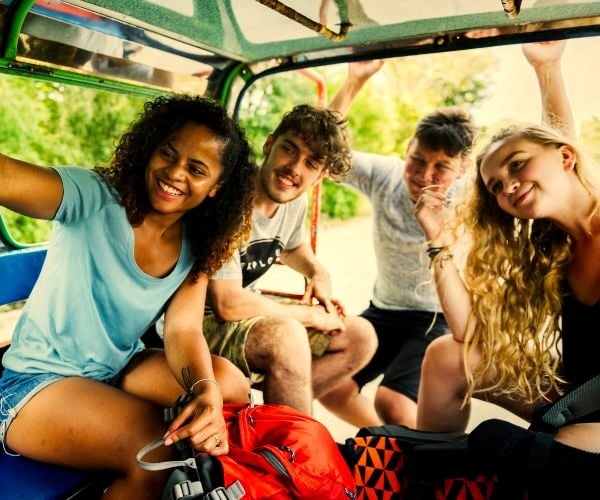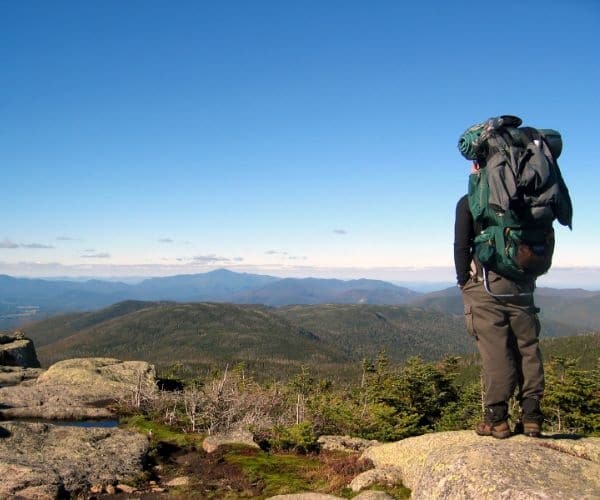Scroll your For You Page right now and there’s a good chance you’ll see someone hiking a volcano at sunrise, teaching English on a Thai island, or drinking coffee in a colourful Lisbon backstreet. TikTok has become the unofficial travel agent for a whole new generation of gap year travellers – and in 2025, it’s shaping how people plan, book, and share their adventures.
The hashtag #GapYear2025 has already racked up millions of views, with creators showing everything from budget breakdowns to hidden gem recommendations. This means your gap year planning now has a visual, real-time research tool at your fingertips. But with all those dreamy videos flooding your feed, it can be tricky to decide where to go and what to do.
Here’s your guide to the top trending gap year destinations, activities, and planning tips, with a few practical reminders TikTok might not tell you about.
TikTok’s most popular gap year destinations for 2025

If TikTok had a “Most bookmarked” travel list, these places would be top of the feed.
Bali, Indonesia
Still the undisputed king of budget adventure travel. Think sunrise hikes up Mount Batur, surfing in Canggu, digital nomad cafés in Ubud, and affordable co-living spaces. TikTok loves Bali for its mix of wellness retreats, nightlife, and affordable long-term stays. Learn more from Indonesia’s official travel site.
Lisbon & Porto, Portugal
European charm meets budget-friendliness. TikTok creators are raving about tiled streets, Pastel de nata, and ocean-view coworking spots. Perfect for those who want a mix of culture and city life.
Tokyo, Japan
From neon streets in Shinjuku to work exchange programs in rural Japan, this is where tech, tradition, and travel collide. A 2025 TikTok trend? “Otaku gap years” – combining anime culture, language learning, and seasonal work. Japan Travel’s official site is a great starting point for planning.
Costa Rica
Eco-volunteering, turtle conservation, and rainforest adventures dominate the TikTok clips from here. A favourite for travellers looking for nature-based projects and sustainability experiences.
South Africa
Marine conservation in Cape Town, safari volunteering in Kruger National Park, and some of the world’s best hiking trails. It’s also appearing in TikTok budget travel guides thanks to its affordability for long stays.
The hidden gems TikTok loves
Some of these are still under the radar – but that’s what makes them perfect for avoiding overcrowded “Insta-famous” spots.
Hoi An, Vietnam
Lantern-lit nights, river boat rides, and traditional cooking classes. Often paired with slow travel down the Vietnamese coast. TikTok travel vloggers often highlight how Hoi An combines authentic culture with a relaxed atmosphere, making it a perfect base for travellers who want to slow down and experience life at a gentler pace.
Georgia (the country)
Snow-capped mountains, ancient monasteries, and – TikTok’s new obsession – it’s wine culture. Still very affordable for long-term travellers, Georgia is gaining attention for its warm hospitality and ease of travel for budget backpackers. Many creators are showing homestays in the Caucasus Mountains where you can learn bread-baking and wine-making from locals.
Laos
The slow boat to Luang Prabang has become a bucket-list journey for the gap year crowd. Waterfalls, French colonial architecture, and riverbank guesthouses keep it peaceful and low key. TikTok travel diaries often focus on the slower rhythm of life here, from quiet temple visits to cycling through rice paddies, a reminder that not every gap year needs to be high-energy.
What to do on a gap year TikTok trend edition
TikTok has turned gap year planning into a buffet of ideas. Here are the most popular styles of gap year you’ll see trending in 2025:
Volunteering abroad
From teaching English in rural schools to helping build eco-villages, volunteering gives you purpose while travelling. TikTok is particularly pushing animal welfare projects, like elephant sanctuaries in Thailand or penguin conservation in South Africa. GoAbroad’s volunteering program listings are a good place to start exploring options.
Adventure travel
If your FYP is full of skydiving videos and glacier hikes, you’re not alone. New Zealand, Iceland, and Patagonia are trending for thrill-seekers. TikTok clips often feature “challenge itineraries”, like ticking off multiple adrenaline sports in one week.
Skill building
Language immersion is huge on TikTok right now, with travellers sharing their progress in Spanish, Japanese, or Portuguese over a few months abroad. Others are documenting courses in traditional cooking, photography, or scuba diving, skills that can add lasting value to your gap year beyond the photos.
Work abroad
Classic gap year earn-and-learn jobs are making a comeback: au pairing in France, ski resort work in Canada, hostel jobs in Australia. The UK government’s working holiday visa page is a good first stop for official advice if you’re eligible.
Slow travel
The anti-burnout travel trend. Living a month or more in one place to truly get to know it, TikTok loves these “day in my life abroad” vlogs. This style of travel has been linked to more sustainable tourism, as it reduces the environmental impact of constant moving while deepening your cultural connection.
How to plan TikTok-worthy gap year

Sure, TikTok is full of dreamy travel reels, but behind every “I just booked a one-way ticket” post is a lot of planning.
Choose a mix of spots
Blend trending destinations with hidden gems to avoid burnout from overcrowded tourist hotspots.
Budget like a creator
Many TikTokers share daily budgets – use these as a guide, but factor in personal spending habits, insurance, and emergencies.
Paperwork matters
Visa requirements, working holiday permits, vaccinations, and any cultural etiquette research should be done early.
Leave room for spontaneity
A rigid schedule means you might miss unexpected opportunities – like joining friends you meet on the road for an unplanned side trip.
Gap year travel insurance: the bit TikTok doesn’t show you

While TikTok videos are full of scenic hikes and cute hostels, you’ll rarely see a clip about what happens if something goes wrong.
If your plans involve adventure sports, volunteering, or long-term travel, insurance isn’t optional – it’s essential. A sprained ankle on a mountain trek or a stolen backpack in a crowded market can turn into a financial headache fast.
Good gap year travel insurance should cover:
- Emergency medical expenses
- Trip cancellations or interruptions
- Lost, stolen, or damaged luggage
- Adventure and sports activities
- Long-duration trips
The 2025 gap year mindset
In 2025, the gap year isn’t just for 18-year-olds fresh out of school. TikTok has normalised mid-career breaks, digital nomad sabbaticals, and skill-building years abroad for all ages.
The biggest mindset shift?
Sustainability – choosing eco-conscious activities and avoiding over-tourism.
Community – using online platforms to find travel companions and local experiences.
Balance – mixing adventure with rest, so you come back inspired rather than exhausted.
Get specialist Adventure Travel Insurance from SportsCover Direct
Another essential thing to consider before setting off on a gap year filled with adventure activities is insurance cover. Trekking, diving, surfing, and other adrenaline-filled pursuits can make your travels unforgettable, but they also come with risks. If you need medical help or rescue assistance while abroad, the costs can quickly escalate and become far more complicated to deal with than at home.
SportsCover Direct is a leading provider of specialist adventure travel insurance for trips both in the UK and abroad. Our cover means that if you fall ill, get injured, require rescue assistance, face disruption, or lose your luggage, we can give you the support you need so you won’t be left out of pocket.
For travellers planning to backpack through multiple countries, we also offer tailored backpacking travel insurance to suit the unique needs of on-the-go adventures.
Learn more about our adventure travel insurance policies here.
This blog has been created as general information and should not be taken as advice. Make sure you have the correct level of insurance for your requirements and always review policy documentation.